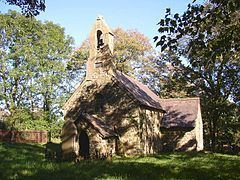Population 932 (2011) Sovereign state United Kingdom Postcode district SA66 7 Local time Tuesday 7:35 PM | Country Wales Post town Clynderwen Police Dyfed-Powys Dialling code 01437 | |
 | ||
Weather 8°C, Wind S at 21 km/h, 100% Humidity | ||
Clynderwen (Welsh: Clunderwen) (SN133198) is a rural village lying in the traditional county of Carmarthenshire, Wales, (however administered as part of Pembrokeshire) between Llandissilio village and the town of Narberth. The village is known as a camping destination and is popular for self-catering holidays. It is also a community in the administrative county of Pembrokeshire, with its own community council of 10 members.
Contents
Map of Clynderwen, UK
History
The earliest known record of Clynderwen (English: thicket of oak) is in 1822: a mansion and farm of that name, the Clynderwen Estate, which stood (and still stands) to the east of the present village and may have dated back to the 17th century. The village was named after the estate. Robert Frederick Gower, High Sheriff of Pembrokeshire in 1844, whose son Erasmus Gower rose to the rank of admiral, owned Clyn Derwen (sic).
Clynderwen was listed in The Welsh Church Year Book of 1929 as having a Chapel of Ease in the parish of Llanfallteg with Clynderwen with Castell Dwyran and had been listed in the parish of Castell Dwyran since before 1850.
The village is on the A478 Tenby to Cardigan road and developed after the advent of the railway in 1854. The Great Western Railway (West Wales Line) to London from the ports of Milford Haven and Fishguard passes through the village at Clunderwen railway station. From 1876 a light railway, the Narberth Road and Maenclochog Railway ran from Clynderwen to Rosebush slate quarries via Maenclochog. The line was closed to passengers in 1937 and to freight in 1949.
The railway encouraged the development of the local economies and Clynderwen became a focus for agricultural produce and livestock shipment. Clynderwen and Cardiganshire Farmers cooperative opened its first branch in the village in 1904, the first of 22 covering much of Wales. The cooperative was a prime mover in a number of agricultural advances and projects beneficial to the farming community particularly during the depression in the 1920s and the technical revolutions after World War 2. The Clunderwen Agricultural Society was established in 1911 and held an annual show until 1963 and from 1979 to the present. The Clunderwen Young Farmers Club, established 1929, was the first in Wales.
The village was notable for the efforts of the James brothers who in 1913 were the first men in Pembrokeshire to build and fly their own aircraft.
On 1 April 2003, the village was transferred from the administrative county of Carmarthenshire to that of Pembrokeshire, following a boundary change between the counties. At the same time, a name change to Clunderwen was proposed to reflect the actual usage by the community council and on road and other signs.
Nant-y-cwm Steiner School
The nearby Nant-y-Cwm School is an independent Steiner school. It is a co-educational day school offering Steiner Waldorf education to pupils from the age of three to 14 split between the kindergarten (ages 3–6) and the main school (ages 6–14). It was founded in 1979 in a converted Victorian building that was originally the village school for Llanycefn. Originally the school was known as the Llanycefn Board School and ran from 1877 to 1964. The original school records are available to view at the Pembrokeshire Records Office in Haverfordwest.
The Kindergarten building which opened in 1991 was designed by architect Christopher Day. The design of the Kindergarten building attempts to infuse the Steiner philosophy into architecture and this is manifested in its organic feel and low visual impact. Kraftl (2006) examines the ways in which this "environmentally friendly, ‘ecological’ structure was (and is) constructed such that the building and its accompanying practices might be seen as ‘performed art’". He goes on to say that art and nature are "crucial to the type of education there, the physical process of building the school, and daily uses of the buildings".
